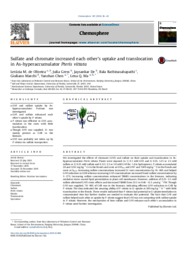Sulfate and chromate increased each other's uptake and translocation in As-hyperaccumulator Pteris vittata.
Sulfate and chromate increased each other's uptake and translocation in As-hyperaccumulator Pteris vittata.
Author(s): OLIVEIRA, L. M. de; GRESS, J.; DE, J.; RATHINASABAPATHI, B.; MARCHI, G.; CHEN, Y.; MA, L. Q.
Summary: Abstract: We investigated the effects of chromate (CrVI) and sulfate on their uptake and translocation in Ashyperaccumulator Pteris vittata. Plants were exposed to 1) 0.1 mM CrVI and 0, 0.25, 1.25 or 2.5 mM sulfate or 2) 0.25 mM sulfate and 0, 0.5, 2.5 or 5.0 mM CrVI for 1 d in hydroponics. P. vittata accumulated 26 and 1261 mg kg1 Cr in the fronds and roots at CrVI0.1, and 2197 and 1589 mg kg1 S in the fronds and roots at S0.25. Increasing sulfate concentrations increased Cr root concentrations by 16e66% and helped CrVI reduction to CrIII whereas increasing CrVI concentrations increased frond sulfate concentrations by 3e27%. Increasing sulfate concentrations enhanced TBARS concentrations in the biomass, indicating oxidative stress caused lipid peroxidation in plant cell membranes. However, addition of 0.25e2.5 mM sulfate alleviated CrVI's toxic effects and decreased TBARS from 23.5 to 9.46e12.3 mmol g1 FW. Though CrVI was supplied, 78e96% of CrIII was in the biomass, indicating efficient CrVI reduction to CrIII by P. vittata. The data indicated the amazing ability of P. vittata in Cr uptake at 289 mg kg1 h1 with little translocation to the fronds. These results indicated that P. vittata had potential in Cr phytoremediation in contaminated sites but further studies are needed to evaluate this potential. The facts that CrVI and sulfate helped each other in uptake by P. vittata suggest that CrVI was not competing with sulfate uptake in P. vittata. However, the mechanisms of how sulfate and CrVI enhance each other's accumulation in P. vittata need further investigation.
Publication year: 2016
Types of publication: Journal article
Unit: Embrapa Cerrados
Observation
Some of Embrapa's publications are published as ePub files. To read them, use or download one of the following free software options to your computer or mobile device. Android: Google Play Books; IOS: iBooks; Windows and Linux: Calibre.
Access other publications
Access the Agricultural Research Database (BDPA) to consult Embrapa's full library collection and records.
Visit Embrapa Bookstore to purchase books and other publications sold by Embrapa.

